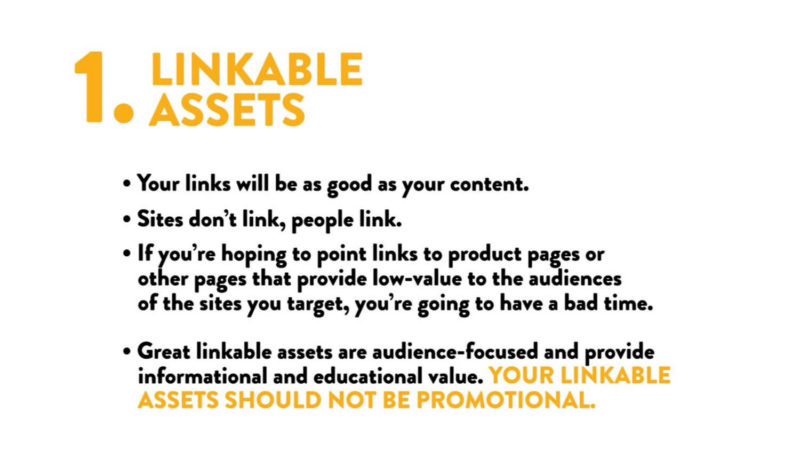The pillars of successful link building
Create linkable assets and identify relevant opportunities to reach a wider audience.
Creating high-quality content can strengthen your business’ branding and facilitate conversions, but not if your audience is never exposed to that content. Link building can help boost content visibility via other websites and in the search results.
Michael Johnson, sales manager at Page One Power, explained how to create and leverage linkable assets, identify relevant linking opportunities, communicate with site owners in a way that compels them to link to your content and what to do after you’ve acquired a link during his talk at SMX Next (free registration) last week.
Create audience-focused, linkable assets
“Your links will be as good as your content,” Johnson said, explaining that the more valuable your content is to your target audiences, the more likely you’ll be able to attract links to that content.

Johnson cautions against requesting links to lower-value promotional content or product pages as they may come across as paid links, which may also discourage users from clicking through.
Identify relevant, valued and trusted sites for links
Johnson uses the following criteria to evaluate which sites are right for any given link building campaign.
Relevance. Your link should be relevant with respect to both the context of the page it appears on as well as the page’s audience.
Value for users. The page you’re interested in getting a link from should receive traffic and engage and provide value to an audience. And of course, be sure the anchor text in the link helps set user expectations when they click through.
Trust and authority. “Look at the backlinking neighborhood of the website that you’re reaching out to,” said Johnson, “If you see that they are linking out to a lot of spam or are posting low quality content on their website, those are red flags that mean you should probably avoid that website.”
Tools and metrics. To help gauge site authority, Johnson suggests looking at metrics such as Ahref’s Domain Rating, Moz’s Domain Authority and Majestic’s Trust Flow and Citation Flow. With a caveat: “I cannot stress enough, do not get too hung up on Domain Authority,” Johnson said, explaining that, while these third-party metrics are useful for getting a general idea of the kinds of sites to reach out to, they are not used by Google and fixating on them can result in lost opportunities.
Vet every site. Thoroughly investigate each site you want a backlink from. “Always ask yourself the question, ‘In a world without Google, would I still want this link?’” he said, adding, “If the answer is no, then you have to question whether or not that’s an organic link.”
Get creative with your link building outreach
“Sites don’t link, people link,” Johnson said, emphasizing that there are people behind every step of the link building process. “When you’re creating content, think about the people behind that . . . When you’re outreaching to that site, think about who you’re connecting with,” he said.
Sending sincere, personalized outreach can make your communications more memorable and increase the likelihood of building a mutually beneficial connection with another site. One way to approach this is to connect with site owners outside of email, via social media or through a direct phone call.
You should also let site owners know how linking to your content benefits them and their users. This is where having informative, audience-focused content is essential: “If you don’t have a great piece of content, if you’re not really building that connection, they’re going to ask for money, and we don’t want to pay for links,” said Johnson.
“You can also learn from not getting responses,” Julie Joyce, owner of Link Fish Media, wrote in her contributed article Why isn’t my fabulous content attracting quality links?, recommending that link builders take a look and compare the subject lines of emails that got opened with the ones that didn’t.
Related: Is link building dead? Depends on who you talk to
Keep the momentum after the link
After acquiring a link, link builders should send a followup communication thanking the site owner. “If you send a thank you, it really does foster goodwill between your brand and theirs,” Johnson said.
Link builders should keep track of the links they’ve acquired so that they can periodically check on their status. “It’s totally acceptable to follow up and say, ‘Hey, I saw that my link is no longer on the page,’” he said. Finding out why your link was removed may enable you to get it back or signal that it’s time to update your content.
Johnson also recommends paying attention to the internal linking of the page that earned the backlink. Since product or promotional pages are unlikely to garner many of their own backlinks, internally linking those conversion-based pages to pages with a stronger backlink profile can help you funnel link equity to them, Johnson said.
Opinions expressed in this article are those of the guest author and not necessarily Search Engine Land. Staff authors are listed here.
Related stories